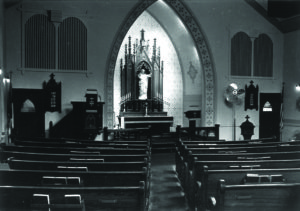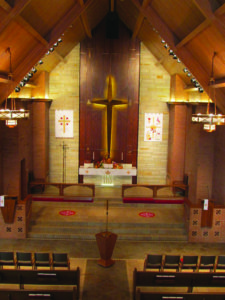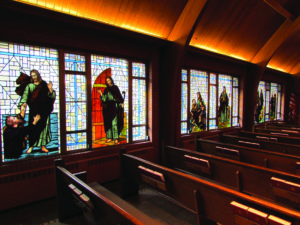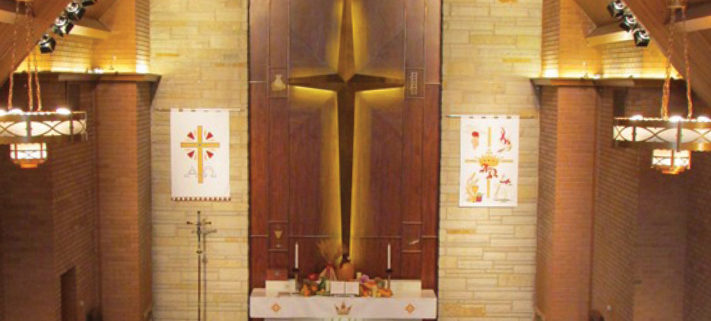Renovation: Morton Grove, Illinois
Jerusalem, Morton Grove was founded in 1902 on the north edge of Chicago. Back then it was a farming community made up of mostly German immigrants. A first sanctuary was built in 1903 and renovated in 1929 after a fire destroyed much of the interior. Arch-shaped, stained-glass windows were added at that time. They were fabricated by the Milwaukee studios of Carl Reimann, who provided many Wisconsin Synod sanctuaries of that era with iconic, biblical scenes as depicted by German artist Heinrich Hofmann.
After the Great Depression and World War II, Morton Grove ceased being a sleepy, farming village and instead became part of a bustling, metropolitan area. Families snatched up the tidy rows of new suburban housing. Many new residents were Lutherans seeking a new church home. Baby-boom families flocked to utilize Jerusalem’s quickly growing grade school. The membership swelled to nearly 800 at its height, and soon the old 1903 structure was deemed inadequate and in need of replacement.
Under the leadership of Pastor George Boldt, who had been installed in 1955, the congregation resolved to build a new sanctuary, laying its cornerstone in 1963. The new church would double the congregation’s seating capacity and provide additional room for the school’s gospel ministry as well. Reimann’s stained-glass windows were preserved and set within a panoply of multi-colored rectangles along the west wall of the worship space, but everything else was new.
This new sanctuary served the congregation well for forty years, but by the turn of the millennium what had been new was no longer. The basic structure of the sanctuary was still solid and sound. In many ways it was even timeless, with its red-brick walls and rich, wooden ceilings. But what was considered cutting-edge in the 1960s was no longer modern, and what had once been considered an ecclesiastical luxury—such as red carpeting down the aisles and in the chancel—was now identified by leaders as a serious impediment to both ministry and maintenance.
The intervening years had also taken its toll on Jerusalem’s membership, due in large part to a steep rise in the cost of residing in an inner-ring Chicago suburb. Pastor Boldt famously joked about “Mortgage Grove,” but the flight of Jerusalem members to Chicago’s far-reaching suburbs and a severely-declining birthrate now compelled the congregation to view gospel ministry differently. By the early 2000s, Jerusalem’s membership numbers had fallen to less than 400, and worship attendance had fallen in kind.
It was becoming clear that the congregation could no longer rely on growth from within. The Lord Jesus was graciously leading his people in Morton Grove to reach out with the gospel in a determined way. And what opportunities he was providing! The surrounding community now included mostly-professional people from all walks of life and from many tribes and nations. In recent years, many immigrants from East Asia, Eastern Europe, and the Mideast have moved into the area. This required the members of Jerusalem to reconsider their approach to ministry and mission through their church and school. As part of the overall ministry reconsideration, it was time for the congregation to evaluate its worship space and to ask questions about our current sanctuary’s function and form. Many members desired to improve the function of the sanctuary, to allow for more flexibility of use, and to enhance the beauty of the sanctuary.
Lighting
When the new sanctuary was built in 1963, the latest technologies in lighting were utilized. While the congregation experienced an improvement over the lighting provided in the 1903 building, this system still left the sanctuary quite dim. Dark red carpeting was placed in the aisles. The only natural light into the sanctuary was mostly provided through the west-facing stained glass windows, meaning that morning services saw little in the way of sunshine. Older members had difficulty seeing their hymnals, and the shadowy sanctuary was less than inviting to the visiting eye.
When the first phase of sanctuary renovation work began in the summer of 2008, the lighting system was the first item addressed. New pendants shed much additional light on the floor, adding vibrancy the space. Perhaps most striking, however, was the light these pendants cast upward on a lovely sanctuary ceiling that had too long dwelt in darkness. Proper lighting alone has done a world of good and enhanced the congregation’s worship greatly.

Before: a dark 1960s chancel
Small spotlights were also installed which highlight three stone reliefs symbolizing the Trinity on the east wall of the sanctuary. Cove lighting along the sanctuary perimeter provided additional warmth to the worship setting. An easy-to-use control panel made lighting entirely dimmable. This panel makes it possible to set up a variety of lighting levels for the sanctuary as well as to focus spot lighting on select areas. This has enabled us to have a variety of lighting schemes for special services such as Tenebrae on Good Friday and Candlelight Services on Christmas Eve.
Before the installation of new lighting, the chancel area was rather dim. New spotlight track lighting brightened the chancel significantly. One long time member commented on how he never realized how beautiful the brick and stone work looked in the chancel area until after the new lighting was installed. Another member expressed that the chancel has a more comfortable and intimate feel when going to communion.
Seating and Flooring

After: a well-lit and inviting space
The second issue to be tackled was seating. The 1963 sanctuary was designed to provide comfortable seating for an assembly of 300 people, all with affixed pews. But with attendance in a single Sunday service now rarely exceeding 125 people, a former ministry necessity had become a ministry hindrance. Worshipers would often be welcomed to an empty-looking sanctuary, giving the wrong impression that Jerusalem was a less-than-vital congregation. Some longtime members had also become accustomed to sitting in the rear of the sanctuary under the balcony, meaning that the main seating area was often sparsely populated. The pews had been placed closely together which made it difficult for some members to get in and out of the pews.
Ultimately it was decided to remove the pews from the under the balcony to bring worshipers together in the main seating area. This also provided a flexible gathering space in the back of the sanctuary that could be used for overflow seating, classroom space during the week, and small fellowship gatherings. Several rows of pews were removed from the main seating area to provide more comfortable leg room. The pews nearest the chancel and those in the balcony were replaced with interlocking, upholstered chairs to offer flexibility, especially for musicians and other service participants. Space was also provided throughout the sanctuary for physically-handicapped seating, when necessary.
This second phase of renovation commenced in the summer of 2009 and included new sanctuary flooring. The red aisle carpeting was completely removed along with the crumbling asbestos floor tile under the pews. In its place ceramic tile was laid, with different colors and sizes for the aisles (large gray tile) and under the pews (standard cream-color tile). A checkered border between the tile added aesthetic interest, as did a mosaic of the Luther Rose near the entry.
The Luther Rose mosaic near the entry serves as a focal point as worshipers enter the center aisle. Some first-time visitors have noticed it and asked what the symbolism is all about. One member says that when she invites a friend to church, she points them to the Luther Rose mosaic and explains how it symbolizes our faith in Christ and the blessings he brings.
When the chancel flooring was similarly replaced during a third phase in the spring of 2011, two mosaic Jerusalem crosses added to the sanctuary’s Christian symbolism. Not only did the ceramic tile provide beauty (especially through light refraction), durability, and ease of maintenance, it improved the sanctuary acoustics dramatically, making electronic amplification virtually unnecessary.
A member commented about acoustical improvement after the new tile flooring was installed: “When we first came to Jerusalem, I was dismayed by the acoustics. I thought the congregation just wasn’t much for singing. After the changes were made I realized that the carpeting was soaking up all the sound!”
Musicians have commented that the improved acoustics have made playing more enjoyable. The sound of singing and instrumental music is definitely more lively. Before the renovations, one musician would often hear from worshipers that they had trouble hearing any instruments. Another musician, who plays violin, notices the difference. She comments about how she “appreciates the presence the violin now has; it’s there, giving me feedback, resonating through the sanctuary, the natural tones of my instrument flowing out and returning to me, lifting my playing.”
Artistic and Musical Enhancements
Over the next several years, the congregation concentrated on smaller projects that would enhance the worship space through artistic and musical expression. New banners were purchased to highlight the changing seasons of the Church Year and their different biblical themes that symbolize and inform the Christian life. The sacristy was renovated to provide a better working space for the altar guild, including cabinetry to store the paraments and banners. A grand piano was placed near the chancel to provide variety in the leading of worship. An historic 1904 copy of Heinrich Hofmann’s Christ in Gethsemane was restored and regained a place of prominence in the sanctuary. This painting had hung behind the altar in Jerusalem’s first sanctuary and was spared in the 1929 fire. For many years it had been relegated to a balcony stairwell, collecting dust and going unnoticed. Now it was hung again in the sanctuary, viewable upon entry as an explicit reminder of Jesus’ patient suffering for our salvation.
Stained Glass Window Renovation

Stained glass windows
A final touch to Jerusalem’s sanctuary renovation work was provided in 2015 when the stained glass windows were repaired and expanded with the help of the Conrad Schmitt Studios of New Berlin, WI. The biblical scenes that had once been set in arched frames in Jerusalem’s first sanctuary now received similar artistic settings that outshone their predecessors, as the Hofmann depictions were supplied with their original context. The addition of south-facing windows that illustrated Jesus’ birth and crucifixion, alongside scenes of his baptism and institution of Holy Communion, highlighted significant events in his work of salvation that had not been included in the original set of 1929 windows. These high vertical windows in the rear of the sanctuary were crowned with scenes of the two great kings of Jerusalem, David and Jesus, a reminder of the heavenly Jerusalem to which the eyes of faith are fixed and over which our Savior reigns forever and ever.
The beauty of the windows attracts the eye’s attention and provides good talking points with visitors, members, and children—much like the Luther Rose mosaic. Some visitors have commented on the windows and asked about them. This provides an opportunity to share the gospel message which the windows convey and that the members of Jerusalem want this good news to be the heart and focus of our mission, ministry, and worship.
Conclusion
When some of the changes to the sanctuary were first proposed, some felt that they were not needed or at least didn’t need to be a high priority. The thought was “if it ain’t broke, don’t fix it.” After the work was complete, one member commented on changed attitudes: “The renovations have helped many people, especially myself, realize that change can be good when trying to give God our best and reach out to the community. Many people who visit say, ‘Your church is beautiful.’ While the church’s goal isn’t to be materialistic about the beauty, artistry can give glory to God and serve as a ministry tool. It can be appealing for people who come in off the street and see what’s inside.”
Cultural expectations are high in Morton Grove. Many improvements have made Jerusalem’s worship space inviting for members and visitors while also providing facility flexibility for gospel ministry in a fluid, metropolitan setting.
Written by Peter Prange
Peter Prange is pastor at Bethany, Kenosha, WI. He previously served at Jerusalem, Morton Grove, IL when a renovation project was begun. His service to the church at large includes the committee that prepared Christian Worship Supplement and co-authoring Jars of Clay, a history of Wisconsin Lutheran seminary. He served on the Commission on Inter-Church Relations from 2004-2017.
The final renovation work at Jerusalem wasn’t finished until after Prange had accepted a call away. Some insights into the blessings of the completed project, woven into the article above, come from Jerusalem’s current pastor, Jonathan Kehren.
Additional photos of the renovation project are available at worship.welsrc.net/download-worship/worship-the-lord-renovation-projects.
Acoustics in the Worship Space
A nine-part series of articles by consultant Scott Riedel is available at riedelassociates.com. Riedel’s company has served numerous WELS clients (and not only regarding acoustics), including Wisconsin Lutheran Seminary, Martin Luther College, Luther Preparatory School, and Michigan Lutheran Seminary.
Renovation, gospel impact, challenges, blessings
Pastor Prange comments on measurable outcomes from this remodeling project, one that didn’t have a simplistic “build it and they will come” strategy.
Jerusalem’s everlasting struggle will be its low visibility and trying to do ministry in what has become a strongly secular community with a very low tolerance for basic biblical truths, much less those that are more challenging.
The truth is that, in terms of gospel ministry impact, a school renovation Jerusalem undertook had a much greater positive impact on their ministry than the sanctuary renovation, opening some doors for introducing people to Jesus and/or deepening their understanding of the gospel. Even now, school enrollment is maxing out, while the membership and worship attendance continue to decline (but with a slight uptick in 2016). Transitioning people from school to church has been a challenge.
If your congregation is unsure about what priorities should receive highest attention and when, check out various options from WELS Commission on Congregational Counseling, ccc.welsrc.net. For a variety of resources to help with improving transition from school (LES or early childhood) to church, find “Telling the Next Generation: Utilizing Schools for Outreach” at cls.welsrc.net.
Here are three resources that might be helpful when people have questions about the value and cost of excellence. All are available at worship.welsrc.net.
“Sermon at the Dedication of the Seminary Chapel Organ,” by James Tiefel, Wisconsin Lutheran Quarterly, Fall 1991, v88.4. Look under “Valuable Worship Reading.” Excerpt:
So, when we dedicate ourselves to what is lovely and worthy of praise, we are really doing it on the basis of nothing less than an apostolic encouragement…. We do not have to invent some convoluted defense for the joy we feel as we pursue art and music—and that is right, when we pursue a musical instrument—which are lovely and worthy of praise…. We can enjoy and strive for those things which even unbelievers—to say nothing of countless believers—consider to be among the highest forms of artistic expression known to man and among the noblest contributions western civilization has ever made to society…. We can use our time and engage our energy and spend our money on what is also lovely and praiseworthy among human beings.
“Excellence for Christ in All Things,” by Aaron Christie in Worship the Lord No. 42, May 2010. Excerpt:
When our new sanctuary was built, a few voices raised questions about the granite top on our altar. But dozens of members’ homes have granite counter tops. If dozens of members’ children eat Cheerios at a granite-topped breakfast bar, might the Lord’s Supper be worth the same level of quality? The granite top on the new altar wasn’t opulent. It is simply putting into practice what David said to Nathan: “Here I am, living in a palace of cedar, while the ark of God remains in a tent” (2 Samuel 7:2). In our suburban American context, the granite altar top was excellent, not opulent.
“Excellence in Worship,” by James Huebner, the keynote address from the 1999 WELS national worship conference. Look under “Valuable Worship Reading.”
[fbcomments num=”5″]


